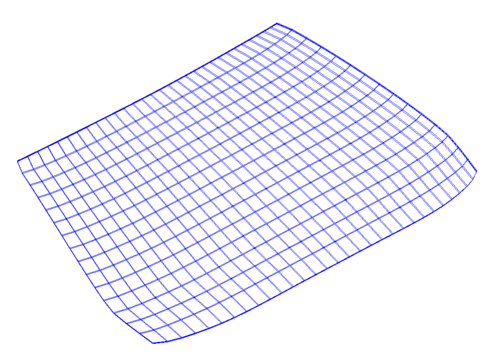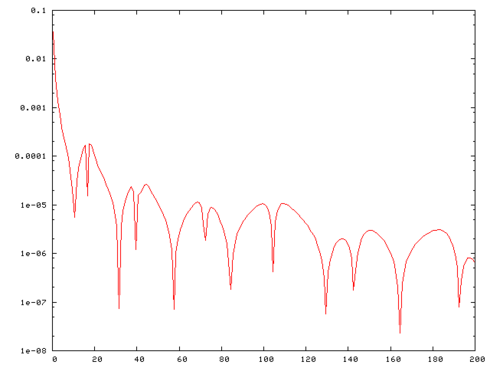| (23 intermediate revisions by 7 users not shown) | |||
| Line 1: | Line 1: | ||
| ⚫ | |||
| − | {{preliminary}} <!-- Do not remove --> |
||
| + | [[Category:Oberwolfach]] |
||
| + | [[Category:Linear]] |
||
| + | [[Category:Affine parameter representation]] |
||
| + | [[Category:Parametric]] |
||
| + | [[Category:SISO]] |
||
| + | [[Category:Sparse]] |
||
| + | {{Infobox |
||
| − | |||
| + | |Title = Windscreen |
||
| ⚫ | |||
| + | |Benchmark ID = windscreen_n22692m1q1 |
||
| + | |Category = oberwolfach |
||
| + | |System-Class = LTI-SOS |
||
| + | |nstates = 22692 |
||
| + | |ninputs = 1 |
||
| + | |noutputs = 1 |
||
| + | |nparameters = 0 |
||
| + | |components = B, C, K, M |
||
| + | |License = NA |
||
| + | |Creator = [[User:Himpe]] |
||
| + | |Editor = |
||
| + | * [[User:Himpe]] |
||
| + | * [[User:Mlinaric]] |
||
| + | * [[User:Yue]] |
||
| + | |Zenodo-link = NA |
||
| + | }} |
||
==Description== |
==Description== |
||
| Line 10: | Line 32: | ||
This is an example for a model in the frequency domain of the form |
This is an example for a model in the frequency domain of the form |
||
| − | <math> |
+ | :<math> |
| + | \begin{align} |
||
| − | \begin{array}{rcl} K_d x - \omega^2 M x & = & f \\ y & = & f^* x \end{array} |
||
| + | K x + \omega^2 M x & = B \\ |
||
| + | y & = C x |
||
| + | \end{align} |
||
</math> |
</math> |
||
| − | where <math> |
+ | where <math>B</math> represents a unit point load in one unknown of the state vector, <math>C = B^T </math>, |
| − | <math>M</math> is a symmetric positive-definite matrix and <math> |
+ | <math>M</math> is a symmetric positive-definite matrix, and <math>K = (1+i\gamma) \widetilde{K}</math> with <math>\widetilde{K}</math> symmetric positive semidefinite. |
| − | The test problem is a structural model of a car windscreen. |
+ | The test problem is a structural model of a car windscreen. <ref name="meerbergen2007"/> |
This is a 3D problem discretized with <math>7564</math> nodes and <math>5400</math> linear hexahedral elements (3 layers of <math>60 \times 30</math> elements). |
This is a 3D problem discretized with <math>7564</math> nodes and <math>5400</math> linear hexahedral elements (3 layers of <math>60 \times 30</math> elements). |
||
| − | The mesh is shown in |
+ | The mesh is shown in Fig. 1. |
The material is glass with the following properties: |
The material is glass with the following properties: |
||
| − | The Young modulus is <math>7\times10^{10}\mathrm{N}/\mathrm{m}^2</math>, the density is <math>2490 \mathrm{kg}/\mathrm{m}^3</math>, and the Poisson ratio is <math>0.23</math>. The natural damping is <math>10\%</math>, i.e. <math>\gamma=0.1</math>. |
+ | The [[wikipedia:Young's_modulus|Young modulus]] is <math>7\times10^{10}\mathrm{N}/\mathrm{m}^2</math>, the density is <math>2490 \mathrm{kg}/\mathrm{m}^3</math>, and the [[wikipedia:Poisson's_ratio|Poisson ratio]] is <math>0.23</math>. The natural damping is <math>10\%</math>, i.e. <math>\gamma=0.1</math>. |
The structural boundaries are free (free-free boundary conditions). |
The structural boundaries are free (free-free boundary conditions). |
||
The windscreen is subjected to a point force applied on a corner. |
The windscreen is subjected to a point force applied on a corner. |
||
| − | The goal of the model reduction is the fast evaluation of <math>y</math>. |
+ | The goal of the model reduction is the fast evaluation of <math>y</math>. |
Model reduction is used as a fast linear solver for a sequence of parametrized linear systems. |
Model reduction is used as a fast linear solver for a sequence of parametrized linear systems. |
||
The discretized problem has dimension <math>n=22692</math>. |
The discretized problem has dimension <math>n=22692</math>. |
||
The goal is to estimate <math>x(\omega)</math> for <math>\omega\in[0.5,200]</math>. |
The goal is to estimate <math>x(\omega)</math> for <math>\omega\in[0.5,200]</math>. |
||
| − | In order to generate the plots the frequency range was discretized as <math>\{\omega_1,\ldots,\omega_m\} = |
+ | In order to generate the plots, the frequency range was discretized as <math>\{\omega_1,\ldots,\omega_m\} = |
\{0.5j,j=1,\ldots,m\}</math> with <math>m=400</math>. |
\{0.5j,j=1,\ldots,m\}</math> with <math>m=400</math>. |
||
| − | + | Fig. 1 shows the mesh of the car windscreen and Fig. 2 the frequency response <math>\vert \Re(y(\omega)) \vert</math>. |
|
==Origin== |
==Origin== |
||
| Line 42: | Line 67: | ||
Download matrices in the [http://math.nist.gov/MatrixMarket/ Matrix Market] format: |
Download matrices in the [http://math.nist.gov/MatrixMarket/ Matrix Market] format: |
||
| − | * [https:// |
+ | * [https://csc.mpi-magdeburg.mpg.de/mpcsc/MORWIKI/Oberwolfach/Windscreen-dim1e4-windscreen.tar.gz Windscreen-dim1e4-windscreen.tar.gz] (21.5 MB) |
| − | The archive contains files <tt>windscreen.K</tt>, <tt>windscreen.M</tt> and <tt>windscreen.B</tt> representing <math> |
+ | The archive contains files <tt>windscreen.K</tt>, <tt>windscreen.M</tt> and <tt>windscreen.B</tt> representing <math>K</math>, <math>M</math> and <math>B</math> accordingly. |
==Dimensions== |
==Dimensions== |
||
System structure: |
System structure: |
||
| − | |||
:<math> |
:<math> |
||
\begin{align} |
\begin{align} |
||
| − | + | (K + \omega^2 M) x & = B \\ |
|
| − | y &= |
+ | y & = C x |
\end{align} |
\end{align} |
||
</math> |
</math> |
||
| + | with <math>\omega \in [0.5, 200]</math>. |
||
System dimensions: |
System dimensions: |
||
| − | <math>K \in \mathbb{ |
+ | <math>K \in \mathbb{C}^{22692 \times 22692}</math>, |
<math>M \in \mathbb{R}^{22692 \times 22692}</math>, |
<math>M \in \mathbb{R}^{22692 \times 22692}</math>, |
||
| − | <math>B \in \mathbb{R}^{22692 \times 1}</math> |
+ | <math>B \in \mathbb{R}^{22692 \times 1}</math>, |
| + | <math>C \in \mathbb{R}^{1 \times 22692}</math>, |
||
| + | |||
| + | ==Citation== |
||
| + | To cite this benchmark, use the following references: |
||
| + | |||
| + | * For the benchmark itself and its data: |
||
| + | :: Oberwolfach Benchmark Collection, '''Windscreen'''. hosted at MORwiki - Model Order Reduction Wiki, 2018. https://modelreduction.org/morwiki/Windscreen |
||
| + | |||
| + | @MISC{morwiki_windscreen, |
||
| + | author = <nowiki>{{Oberwolfach Benchmark Collection}}</nowiki>, |
||
| + | title = {Windscreen}, |
||
| + | howpublished = {hosted at {MORwiki} -- Model Order Reduction Wiki}, |
||
| + | url = <nowiki>{https://modelreduction.org/morwiki/Windscreen}</nowiki>, |
||
| + | year = 20XX |
||
| + | } |
||
| + | |||
| + | * For the background on the benchmark: |
||
| + | |||
| + | @article{Mee07, |
||
| + | author = {K. Meerbergen}, |
||
| + | title = {Fast frequency response computation for {R}ayleigh damping}, |
||
| + | journal = {International Journal for Numerical Methods in Engineering}, |
||
| + | volume = {73}, |
||
| + | number = {1}, |
||
| + | pages = {96--106}, |
||
| + | year = {2007}, |
||
| + | doi = {10.1002/nme.2058}, |
||
| + | } |
||
==References== |
==References== |
||
| Line 68: | Line 121: | ||
<ref name="korvink2005"> J.G. Korvink, E.B. Rudnyi, <span class="plainlinks">[https://doi.org/10.1007/3-540-27909-1_11 Oberwolfach Benchmark Collection]</span>, In: Dimension Reduction of Large-Scale Systems, Lecture Notes in Computational Science and Engineering, vol 45: 311--315, 2005.</ref> |
<ref name="korvink2005"> J.G. Korvink, E.B. Rudnyi, <span class="plainlinks">[https://doi.org/10.1007/3-540-27909-1_11 Oberwolfach Benchmark Collection]</span>, In: Dimension Reduction of Large-Scale Systems, Lecture Notes in Computational Science and Engineering, vol 45: 311--315, 2005.</ref> |
||
| + | |||
| + | <ref name="meerbergen2007"> K. Meerbergen, <span class="plainlinks">[https://doi.org/10.1002/nme.2058 Fast frequency response computation for Rayleigh damping]</span>, International Journal for Numerical Methods in Engineering, 73(1): 96--106, 2007.</ref> |
||
</references> |
</references> |
||
Latest revision as of 06:42, 17 June 2025
| Background | |
|---|---|
| Benchmark ID |
windscreen_n22692m1q1 |
| Category |
oberwolfach |
| System-Class |
LTI-SOS |
| Parameters | |
| nstates |
22692
|
| ninputs |
1 |
| noutputs |
1 |
| nparameters |
0 |
| components |
B, C, K, M |
| Copyright | |
| License |
NA |
| Creator | |
| Editor | |
| Location | |
|
NA | |
Description
This is an example for a model in the frequency domain of the form
where  represents a unit point load in one unknown of the state vector,
represents a unit point load in one unknown of the state vector,  ,
,
 is a symmetric positive-definite matrix, and
is a symmetric positive-definite matrix, and  with
with  symmetric positive semidefinite.
symmetric positive semidefinite.
The test problem is a structural model of a car windscreen. [1]
This is a 3D problem discretized with  nodes and
nodes and  linear hexahedral elements (3 layers of
linear hexahedral elements (3 layers of  elements).
The mesh is shown in Fig. 1.
The material is glass with the following properties:
The Young modulus is
elements).
The mesh is shown in Fig. 1.
The material is glass with the following properties:
The Young modulus is  , the density is
, the density is  , and the Poisson ratio is
, and the Poisson ratio is  . The natural damping is
. The natural damping is  , i.e.
, i.e.  .
The structural boundaries are free (free-free boundary conditions).
The windscreen is subjected to a point force applied on a corner.
The goal of the model reduction is the fast evaluation of
.
The structural boundaries are free (free-free boundary conditions).
The windscreen is subjected to a point force applied on a corner.
The goal of the model reduction is the fast evaluation of  .
Model reduction is used as a fast linear solver for a sequence of parametrized linear systems.
.
Model reduction is used as a fast linear solver for a sequence of parametrized linear systems.
The discretized problem has dimension  .
The goal is to estimate
.
The goal is to estimate  for
for ![\omega\in[0.5,200]](/morwiki/images/math/b/b/0/bb02974887d08c7449464802fbf5ea4c.png) .
In order to generate the plots, the frequency range was discretized as
.
In order to generate the plots, the frequency range was discretized as  with
with  .
.
Fig. 1 shows the mesh of the car windscreen and Fig. 2 the frequency response  .
.
Origin
This benchmark is part of the Oberwolfach Benchmark Collection[2]; No. 38886.
Data
Download matrices in the Matrix Market format:
- Windscreen-dim1e4-windscreen.tar.gz (21.5 MB)
The archive contains files windscreen.K, windscreen.M and windscreen.B representing  ,
,  and
and  accordingly.
accordingly.
Dimensions
System structure:
with ![\omega \in [0.5, 200]](/morwiki/images/math/b/b/0/bb02974887d08c7449464802fbf5ea4c.png) .
.
System dimensions:
 ,
,
 ,
,
 ,
,
 ,
,
Citation
To cite this benchmark, use the following references:
- For the benchmark itself and its data:
- Oberwolfach Benchmark Collection, Windscreen. hosted at MORwiki - Model Order Reduction Wiki, 2018. https://modelreduction.org/morwiki/Windscreen
@MISC{morwiki_windscreen,
author = {{Oberwolfach Benchmark Collection}},
title = {Windscreen},
howpublished = {hosted at {MORwiki} -- Model Order Reduction Wiki},
url = {https://modelreduction.org/morwiki/Windscreen},
year = 20XX
}
- For the background on the benchmark:
@article{Mee07,
author = {K. Meerbergen},
title = {Fast frequency response computation for {R}ayleigh damping},
journal = {International Journal for Numerical Methods in Engineering},
volume = {73},
number = {1},
pages = {96--106},
year = {2007},
doi = {10.1002/nme.2058},
}
References
- ↑ K. Meerbergen, Fast frequency response computation for Rayleigh damping, International Journal for Numerical Methods in Engineering, 73(1): 96--106, 2007.
- ↑ J.G. Korvink, E.B. Rudnyi, Oberwolfach Benchmark Collection, In: Dimension Reduction of Large-Scale Systems, Lecture Notes in Computational Science and Engineering, vol 45: 311--315, 2005.




